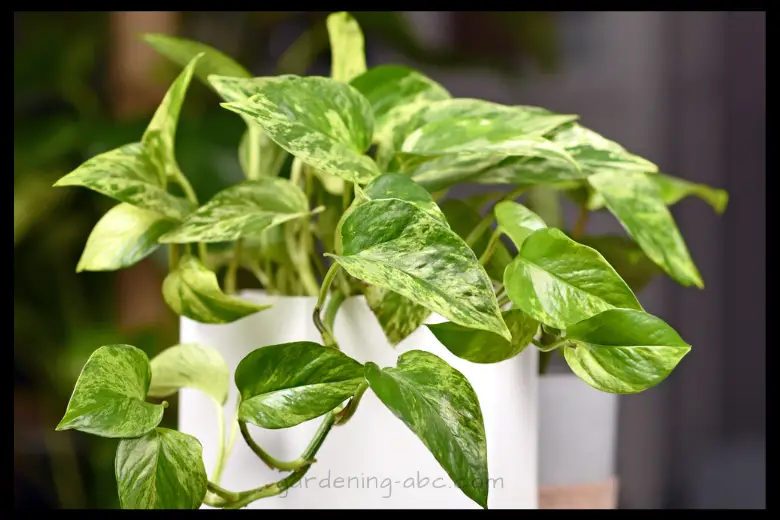We use affiliate links to run our site. When you buy through links on our site, we may earn an affiliate commission, without any added cost to you. Learn more
Pothos plants are a popular choice for those seeking a visually appealing and low-maintenance houseplant. These plants offer several benefits to your home or office.
But in order to keep them healthy and beautiful for years to come, proper care is essential. Whether you already have a pothos plant at home or are considering getting one, this article is the perfect place to start.
We’ve put together ten easy-to-follow tips that cover everything from choosing the right soil and container to keeping your plant clean and healthy.
With these tips, taking care of your pothos plant will be a breeze, and you’ll be rewarded with a thriving and gorgeous plant that adds life and beauty to your space.
Tip 1: Choose the Right Potting Soil and Container
Choosing the right soil and container is essential for the health of your pothos plant. Pothos plants do best in well-draining soil that allows for air circulation around the roots.
You can either use a pre-made potting mix that is designed for indoor plants, or you can make your own mix by using equal parts of peat moss, perlite, and vermiculite.
For choosing a container, make sure it has drainage holes in the bottom to prevent water from sitting in the soil and causing root rot.
You can choose a container that matches your decor or get creative with something unique like a vintage teapot or an old watering can.
Just make sure it’s large enough to accommodate the root system and allow for a bit of extra space for growth.
Tip 2: Provide Adequate Light
Pothos plants thrive in bright, indirect light. This means placing your plant near a window that gets plenty of natural light but not in direct sunlight.
Direct sunlight can burn the leaves and cause damage to your plant. If you don’t have a window that provides enough light, you can supplement with artificial light using a grow light.
If you notice that your pothos plant’s leaves are turning yellow or brown, it may be a sign that it’s not getting enough light. In this case, move it to a brighter spot or add a grow light to provide the necessary light for growth.

Tip 3: Water Properly
One of the most common mistakes people make with pothos plants is that they overwater the plant. Pothos plants do best when the soil is allowed to dry out between waterings. This means you should only water when the top inch of soil feels dry to the touch.
When watering, make sure to always water thoroughly so it reaches the roots. You can either water from the top or bottom of the pot.
If you choose to water from the bottom, place the pot in a saucer of water and allow it to soak up the water for about 15-20 minutes. Then, remove the pot from the water and allow any excess water to drain out.
Tip 4: Monitor Humidity Levels
Pothos plants are native to the tropics and they thrive in humid environments. They prefer humidity levels between 40 and 60 percent.
If the air is too dry, your pothos plant may suffer and develop brown, crispy leaves.
To increase humidity, you can use a humidifier, place a tray of water near your plant, or mist your plant regularly with a spray bottle. I personally prefer a humidifier like this to keep the air around my pothos plant moist and healthy.
Tip 5: Fertilize Regularly
Like all plants, pothos plants need nutrients to grow and thrive. Fertilizing your pothos plant every 2-3 months can provide it with the necessary nutrients.
You can use a balanced liquid fertilizer, diluted to half strength, and apply it directly to the soil. Over-fertilizing can lead to burning the roots of your plant, so be sure to follow the instructions on the fertilizer packaging carefully.
Remember to fertilize your pothos plant during its growing season, which is from spring to summer, as it will be more active and will require more nutrients during this time.
Tip 6: Prune Your Plant
Regular pruning is an important aspect of pothos plant care. Pruning your plant can promote fuller growth and prevent it from becoming leggy or straggly.
It’s best to prune your plant in the spring, just as new growth starts to emerge. You can use sharp, clean scissors or pruning shears to remove any dead or yellow leaves, as well as any long, trailing vines.
You can also trim back the stems and leaves to encourage bushier growth.
Tip 7: Propagate Your Pothos Plant

Pothos plants are very easy to propagate, which means you can create new plants from your existing ones. Propagation can be done through stem cuttings or division.
To propagate through stem cuttings, simply cut a stem with a few leaves and nodes and place it in a jar of water or in potting soil.
Keep the soil moist and the cutting should root within a few weeks. Once the roots have developed, you can plant the cutting in a separate container.
Division involves separating the plant into smaller sections and planting them in their own containers. Propagation is a great way to share your pothos plant with friends or to expand your plant collection.
Tip 8: Keep Your Plant Clean
Your pothos plant is a diva and it deserves to feel fresh. And that means keeping it clean regularly.
Dust likes to stick to everything, including your pothos leaves. And if it builds up too much, it can block your plant’s ability to breathe and absorb light.
Wiping away all that nasty dust buildup will give your plant’s leaves the chance to breathe easy and soak up all the sunshine they can handle.
Don’t forget to towel dry your little green buddy. Grab a towel and gently pat down the leaves and stems. and watch as it shines brighter than ever before.
Tip 9: Stay Vigilant Against Pests
No plant is immune to pests, and pothos plants are no exception. A few of the pests that commonly affect pothos plants include spider mites, mealybugs, and scale insects. Regularly checking your plant for signs of an infestation can help you stay ahead of any pest problems.
Look out for webbing, sticky residue, or tiny bugs on your plant’s leaves or stems. If you do spot pests, you can take action by gently wiping them off with a damp cloth or by using insecticidal soap.
With a watchful eye and quick action, you can keep your pothos plant pest-free and thriving.
Tip 10: Be Patient
Growing a healthy and beautiful pothos plant takes time, so it’s important to be patient. It’s easy to get frustrated when you don’t see immediate results, but remember that plants grow at their own pace.
Don’t be tempted to over-water, over-fertilize, or over-prune your plant in an attempt to speed up its growth. Doing so can actually harm your plant and hinder its growth.
Instead, give your pothos plant time to establish itself and grow naturally. Monitor its progress and make adjustments as needed, but don’t rush it. With patience and care, your pothos plant will grow into a lush and stunning addition to your home or office.
It’s also important to keep in mind that plants go through natural cycles, and may experience periods of slower growth or even dormancy.
During these times, it’s important to continue providing your plant with the proper care and attention, but understand that it may not grow as quickly as it normally does.
Trust the process and be patient, and your pothos plant will reward you with its beauty and vitality.
Conclusion:
Taking care of a pothos plant is a rewarding experience that can bring life and beauty to your home or office. With these ten tips, you now have the knowledge and confidence to properly care for your pothos plant and watch it thrive.
If you found this article helpful, we encourage you to share it with your friends and family who may also be interested in growing a pothos plant. And don’t forget to explore more articles on this site for other helpful tips and tricks on indoor gardening.
Amazon and the Amazon logo are trademarks of Amazon.com, Inc, or its affiliates.

Hi there! My name is Prasenjit and I’m an avid gardener and someone who has grown a passion for growing plants. From my hands-on experience, I have learned what works and what doesn’t. Here I share everything I have learned.

